Parotta
A Parotta is a layered flatbread, originating from the Indian subcontinent, made from maida flour, popular in Southern India. It is a common street food in southern India, especially in Kerala primarily, and then in Tamilnadu,Karnataka Maharashtra and the countries of United Arab Emirates, Sri Lanka etc. There are different types of parotta including coin porotta, Malabari porotta, berotta, etc.
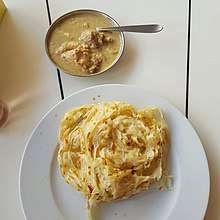 | |
| Type | Flatbread |
|---|---|
| Place of origin | Indian subcontinent |
| Region or state | South India (Tamilnadu, kerala) and Sri Lanka |
| Main ingredients | Maida flour, eggs, ghee or oil |
Parottas are often available as street food[1] and in restaurants across Kerala, Tamil Nadu, Karnataka, Andhra Pradesh and Telangana. At some places it is also served at weddings, religious festivals and feasts. It is prepared by kneading maida flour, egg (in some recipes), oil or ghee and water. The dough is beaten into thin layers and later forming a round spiralled into a ball using these thin layers. The ball is rolled flat and pan fried.[2][3]
Parottas are frequently eaten with vegetable kurma or chicken, fish, mutton or beef saalna (a spicy curry). Chilli parotta and kothu parotta are prepared using parottas.
History
These kind Parotta was introduced from tuticorin of old Madras presidency.
Types of parotta
| Type | Description |
|---|---|
| Poricha Parotta | The dough is prepared the same way as coin parotta. However, after grilling the parotta in a pan, it is shallow fried in oil. |
| Kerala Parotta | Kerala parotta, popularly known as paratha or porotta, is a delicacy from the state of Kerala. |
| Regular Parotta | Regular malabari parotta. |
| Ceylon Parotta | Two layered parotta usually with stuffing in between. Often rectangle in shape |
| Madurai Parotta | Multi-layered parotta, fluffy and soft. Favourite among residents of Madurai |
| Bun Parotta | Version of malabari parotta made into a bun size bake. Softest of all parotta. |
Gallery
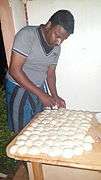 Preparation of balls
Preparation of balls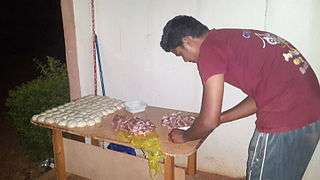 Seasoning of balls
Seasoning of balls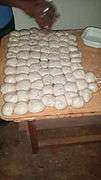 Balls ready to be kneaded
Balls ready to be kneaded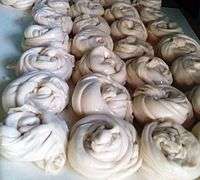 Round spiralled ball of knead dough.
Round spiralled ball of knead dough. Frying Parotta
Frying Parotta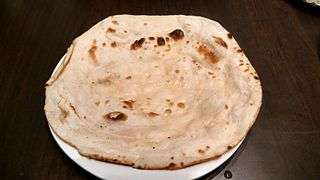 Tandoori Parota
Tandoori Parota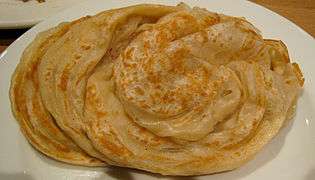 Hot Parottas
Hot Parottas_as_served_in_Tamil_Nadu%2C_India.jpg) Kothu Parotta (with Chicken gravy)
Kothu Parotta (with Chicken gravy)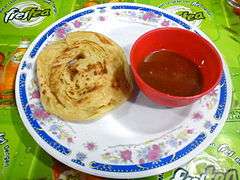 Roti canai, also known as roti parotta
Roti canai, also known as roti parotta
Health impact
Similar to any food product made from Maida (refined flour), Parotta / Malbari Paratha/ Porotta has been deemed unhealthy by some doctors.[4] This has resulted in the introduction and popularization of "atta porotta", which is porotta fully made from atta (whole wheat flour) mostly available only in urban areas.
See also
- Paratha
- Pashti
- Roti prata/Roti canai
- List of Indian breads
- List of Indian dishes
- List of Nepalese dishes
References
- Saravanan, T. (18 January 2013). "Flavours from the footpath". Retrieved 22 December 2019.
- "Kerala Paratha Recipe".
- Kannampilly, Vijayan (2003). The essential Kerala cookbook. Penguin Books. p. 179. ISBN 0-14-302950-9.
- Mallady, Shastry V. (12 August 2013). "Parottas loaded with danger, say docs" – via www.thehindu.com.
External links
| Wikimedia Commons has media related to Parotta. |



